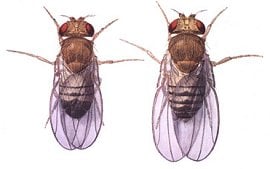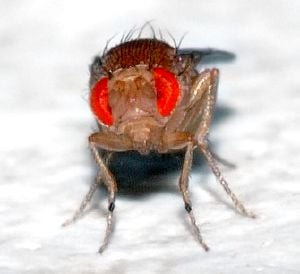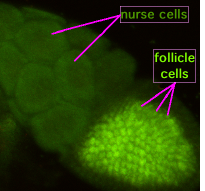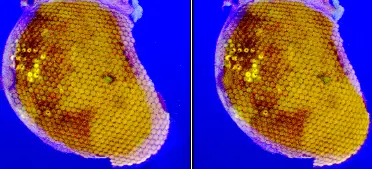Fruit fly
Fruit fly may refer to:
- Tephritidae, the family of large fruit flies.
- Drosophilidae, the family of small fruit flies or vinegar flies, including:
- Drosophila melanogaster, often called the common fruit fly. An important model organism in modern biology.
Tephritidae
| Tephritidae | ||||||||||||||||
|---|---|---|---|---|---|---|---|---|---|---|---|---|---|---|---|---|
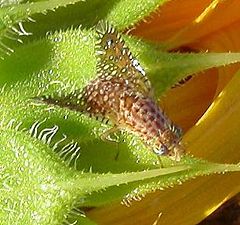 Male Paracantha cultaris | ||||||||||||||||
| Scientific classification | ||||||||||||||||
| ||||||||||||||||
| Genera | ||||||||||||||||
|
500 genera & |
Tephritidae is a family of insects that includes fruit flies. It does not include the biological model organism of the genus Drosophila, which is often called a common fruit fly (that species does not belong to this family, however). There are nearly 5,000 described species of tephritid fruit fly, categorized in almost 500 genera. Description, recategorization, and genetic analysis are constantly changing the taxonomy of the fruit fly family.
Fruit flies are of major importance in agriculture. Some have negative effects, some positive. Various species of fruit fly cause damage to fruit and other plant crops. The genus Bactrocera is of worldwide notoriety for its destructive impact on agriculture. The olive fruit fly (B. oleae), for example, feeds on only one plant: the wild or commercially cultivated olive. It has the capacity to ruin 100% of an olive crop by damaging the fruit. On the other hand, some fruit flies are used as agents of biological control, thereby reducing the populations of pest species. Several species of the fruit fly genus Urophora have been shown to be effective agents against rangeland-destroying noxious weeds such as starthistles and knapweeds.
Most fruit flies lay their eggs in plant tissues, where the larvae find their first food upon emerging. The adults usually have a very short lifespan. Some live for less than a week.
Fruit flies uses an open circulatory system as its cardiovascular system.
Their behavioral ecology is of great interest to biologists. Some fruit flies have extensive mating rituals or territorial displays. Many are brightly colored and visually showy. Some fruit flies show Batesian mimicry, bearing the colors and markings of dangerous insects such as wasps because it helps the fruit flies to avoid predators; the flies, of course, lack stingers.
Economically important Tephritidae
- Mediterranean fruit fly Ceratitis capitata (Wiedemann)
- Olive fruit fly Bactrocera oleae (Gmelin)
- Queensland fruit fly Bactrocera tryoni
Drosophilidae
| Drosophilidae | ||||||||||||||||
|---|---|---|---|---|---|---|---|---|---|---|---|---|---|---|---|---|
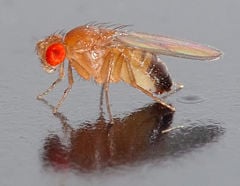 Drosophilia melanogaster | ||||||||||||||||
| Scientific classification | ||||||||||||||||
|
Drosophilidae (Order: Diptera) is a diverse, cosmopolitan family of flies, including the genus Drosophila, which includes fruit flies, vinegar flies, wine flies, pomace flies, grape flies, and picked fruit-flies. The best known species is Drosophila melanogaster that is used extensively for studies concerning genetics, development, physiology, ecology, behaviour, etc.
These flies may have several shades of color, including white eyes and black skin.
Drosophila is a genus of small flies whose members are often called small fruit flies, or more appropriately vinegar flies, wine flies, pomace flies, grape flies, and picked fruit-flies. The terms "fruit fly" and "Drosophila" are often used synonymously with D. melanogaster in modern biological literature. The entire genus, however, contains about 1,500 species and is very diverse in appearance, behavior, and breeding habitat.
Diagnosis
A recent version of the diagnostic characteristics can be found in "Drosophila: A Laboratory Handbook" by M. Ashburner, K. Golic, S. Hawley, (Cold Spring Harbor Laboratory Press, 2005) (not reproduced here due to copyrights).
Phylogeny
The knowledge of the phylogeny of this family is incomplete. The family is subdivided in two subfamilies, the Drosophilinae and the Steganinae. The two subfamilies do not contain a single morphological character that distinguishes them. However, the combination of characterists is sufficient to assign species correctly to the subfamilies.
Most molecular phylogeny studies focus on the genus Drosophila and related genera. Currently, there is no overview of the more than 100 articles using molecular techniques to reconstruct the phylogeny.
Drosophilia melanogaster
| Drosophila melanogaster | ||||||||||||||
|---|---|---|---|---|---|---|---|---|---|---|---|---|---|---|
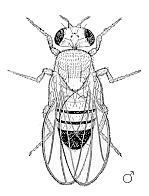 Male Drosophila melanogaster | ||||||||||||||
| Scientific classification | ||||||||||||||
| ||||||||||||||
| Binomial name | ||||||||||||||
| Drosophila melanogaster Meigen, 1830 |
Drosophila melanogaster (from the Greek for black-bellied dew-lover) is a two-winged insect that belongs to the Diptera, the order of the flies. The species is commonly known as the fruit fly, and is one of the most commonly used model organisms in biology, including studies in genetics, physiology and life-history evolution. Flies belonging to the Tephritidae are also called fruit flies, which can lead to confusion.
Physical appearance
The flies have red eyes, a yellow-brown color, with transversal black rings across their abdomen. They exhibit sexual dimorphism: females are about 2.5 millimetres long; males are slightly smaller and the back of their bodies is darker. Males are easily distinguished from females based on colour differences (males have a distinct black patch at the abdomen, less noticeable in recently emerged flies (see fig)) and the sexcombs (a row of dark bristles on the tarsus of the first leg). Furthermore, males have a cluster of spiky hairs (claspers) surrounding the anus and genitals used to attach to the female during mating. There are extensive images at FlyBase.[1]
Life cycle
The developmental period for Drosophila melanogaster varies with temperature, as all cold-blooded species. The shortest development time (egg to adult), 7 days, is achieved at 28 °C. [2][3] Development times increase at higher temperatures (30 °C, 11 days) due to heat stress. Under ideal conditions, the development time at 25 °C is 8.5 [4][2][3], at 18 °C it takes 19 days [2][3]and at 12 °C it takes over 50 days.[2][3] Under crowded conditions, development time increases [5], while the emerging flies are smaller[5][6]. Females lay some 400 eggs (embryos), about five at a time, into rotting fruit or other suitable material such as decaying mushrooms and sap fluxes. The eggs, which are about 0.5 millimetres long, hatch after 12-15 h (at 25 °C).[2][3] The resulting larvae grow for about 4 days (at 25 °C) while molting twice (into 2nd- and 3rd-instar larvae), at about 24 and 48 h after eclosion.[2][3] During this time, they feed on the microorganisms that decompose the fruit, as well as on the sugar of the fruit themselves. Then the larvae encapsulate in the puparium and undergo a four-day-long metamorphosis (at 25 °C), after which the adults eclose (emerge).[2][3]
Females become receptive to courting males at about 8-12 hours after emergence.[7] Males perform a sequence of five behavioral patterns to court females. First males orient themselves while playing a courtship song by horizontally extending and vibrating their wings. Soon after the male positions itself at the rear of the female's adbdomen in a low posture to tap and lick the female genitalia. Finally the male curls it's abdomen, and attempts copulation. Females can reject males by moving away from males and extruding their ovipositor. The average duration of copulation, when successful, lasts 10 minutes, during which males transfer hundreds of very long sperm in seminal fluid to the female. Females store the sperm, which may need to compete with other male's stored sperm to fertilize eggs.
Model organism in genetics
Drosophila melanogaster is the most studied organism in biological research, particularly in genetics and developmental biology. There are several reasons:
- It is small and easy to grow in the laboratory
- It has a short generation time (about 2 weeks) and high productivity (females can lay 500 eggs in 10 days)
- The mature larvae show giant chromosomes in the salivary glands called polytene chromosomes - "puffs" indicate regions of transcription and hence gene activity.
- It has only 4 pairs of chromosomes: 3 autosomal, and 1 sex.
- Males do not show recombination, facilitating genetic studies.
- Genetic transformation techniques have been available since 1987.
- Its compact genome was sequenced in 1998.[8]
Charles W. Woodworth is credited with being the first to breed Drosophila in quantity and for suggesting to W. E. Castle that they might be used for genetic research during his time at Harvard University. Beginning in 1910, fruit flies helped Thomas Hunt Morgan accomplish his studies on heredity. "Thomas Hunt Morgan and colleagues extended Mendel's work by describing X-linked inheritance and by showing that genes located on the same chromosome do not show independent assortment. Studies of X-linked traits helped confirm that genes are found on chromosomes, while studies of linked traits led to the first maps showing the locations of genetic loci on chromosomes" (Freman 214). The first maps of Drosophila chromosomes were completed by Alfred Sturtevant.
The Drosophila genome
The genome of Drosophila contains 4 pairs of chromosomes: an X/Y pair, and three autosomes labeled 2, 3, and 4. The fourth chromosome is so tiny that it is often ignored, aside from its important eyeless gene. The genome contains about 132 million bases and approximately 13,767 genes. The genome has been sequenced [8] and has been annotated. Determination of sex in Drosophila occurs by the ratio of X chromosomes to autosomes, not because of the presence of a Y chromosome as in human sex determination.
Similarity to humans — Genetically, humans are about 44% similar to flies. About 61% of known human disease genes have a recognizable match in the genetic code of fruit flies, and 50% of fly protein sequences have mammalian analogues. Drosophila is being used as a genetic model for several human diseases including the neurodegenerative disorders Parkinson's, Huntington's, and Alzheimer's disease. The fly is also being used to study mechanisms underlying immunity, Diabetes, and cancer, as well as drug abuse.
Development and embryogenesis
Main article: Drosophila embryogenesis
Embryogenesis in Drosophila has been extensively studied, as its small size, short generation time, and large brood size makes it ideal for genetic studies. It is also unique among model organisms in that cleavage occurs in a syncytium.
During oogenesis, cytoplasmic bridges called "ring canals" connect the forming oocyte to nurse cells. Nutrients and developmental control molecules move from the nurse cells into the oocyte. In the figure to the left, the forming oocyte can be seen to be covered by follicular support cells.
After fertilization of the oocyte the early embryo or (syncytial embryo) undergoes rapid DNA replication and 13 nucelar divisions until approximately 5000 to 6000 nuclei accumulate in the unseparated cytoplasm of the embryo. By the end of the 8th division most nuclei have migrated to the surface, surrounding the yolk sac (leaving behind only a few nuclei, which will become the yolk nuclei). After the 10th division the pole cells form at the posterior end of the embryo, segregating the germ line from the syncytium. Finally, after the 13th division cell membranes slowly invaginate, dividing the syncytium into individual somatic cells. Once this process is completed gastrulation starts.
Nuclear division in the early Drosophila embryo happens so quickly there are no proper checkpoints so mistakes may be made in division of the DNA. To get around this problem the nuclei which have made a mistake detach from their centrosomes and fall into the centre of the embryo (yolk sac) which will not form part of the fly.
The gene network (transcriptional and protein interactions) governing the early development of the fruitfly embryo is one of the best understood gene networks to date. Especially the patterning along the antero-posterior (AP) and dorso-ventral (DV) axes (See under morphogenesis).
The egg undergoes well-characterized morphogenetic movements during gastrulation and early development, including germ-band extension, formation of several furrows, ventral invagination of the mesoderm, posterior and anterior invagination of endoderm (gut), as well as extensive body segmentation [9] until finally hatching from the surrounding cuticle into a 1st-instar larva. During the larval development (molting), the imaginal disks form, which are in essence the anlagen for the entire adult body. Cells of the imaginal disks are set aside early and mature over time into adult body structures, especially during pupation, whereas most other cells in the larva undergo apoptosis.
Behavioral genetics and neuroscience
In 1971 Ron Konopka and Seymour Benzer published a paper titled "Clock mutants of Drosophila melanogaster" in which they described the first mutations that affected an animal's behavior. Wild-type flies show an activity rhythm of with a frequency of about a day (24 hours). They found mutants with faster and slower rhythms as well as broken rhythms - flies that move and rest in random spurts. Work over the following 30 years has shown that these mutations (and others like them) affect a group of genes and their products that comprise a biochemical or biological clock. This clock is found in a wide range of fly cells, but the clock-bearing cells that control activity are several dozen neurons in the fly's central brain.
Since then Benzer, his students, and many others have used behavioral screens to isolate genes involved in vision, olfaction, audition, learning/memory, courtship, pain and other processes such as longevity.Furthermore, Drosophila has been used in neuropharmacological research. [10]
Vision in Drosophila
The compound eye of the fruit fly contains 800 unit eyes or ommatidia, and are one of the most advanced among insects. Each ommatidium contains 8 photoreceptor cells (R1-8), support cells, pigment cells, and a cornea. Wild-type flies have reddish pigment cells, which serve to absorb excess blue light so the fly isn't blinded by ambient light.
Each photoreceptor cell consists of two main sections, the cell body and the rhabdomere. The cell body contains the nucleus while the rhabdomere is made up of toothbrush-like stacks of membrane called microvilli. Each microvillus is 1 mm to 1.5 mm in length and 50 nm in diameter. The membrane of the rhabdomere is packed with about 100 million rhodopsin molecules, the visual protein that absorbs light. The rest of the visual proteins are also tightly packed into the microvillar space, leaving little room for cytoplasm.
The photoreceptors in Drosophila express a variety of rhodopsin isoforms. The R1-R6 photoreceptor cells express Rhodopsin1 (Rh1) which absorbs blue light (480 nm). The R7 and R8 cells express a combination of either Rh3 or Rh4 which absorb UV light (345 nm and 375 nm), and Rh5 or Rh6 which absorb blue (437 nm) and green (508 nm) light respectively. Each rhodopsin molecule consists of an opsin protein covalently linked to a carotenoid chromophore, 11-cis-3-hydroxyretinal.[citation needed]
As in vertebrate vision, visual transduction in invertebrates occurs via a G protein-coupled pathway. However, in vertebrates the G protein is transducin, while the G protein in invertebrates is Gq (dgq in Drosophila). When rhodopsin (Rh) absorbs a photon of light its chromophore, 11-cis-3-hydroxyretinal, is isomerized to all-trans-3-hydroxyretinal. Rh undergoes a conformational change into its active form, metarhodopsin. Metarhodopsin activates Gq, which in turn activates a phospholipase Cβ (PLCβ) known as NorpA.
PLCβ hydrolyzes phosphatidylinositol (4,5)-bisphosphate (PIP2), a phospholipid found in the cell membrane, into soluble inositol triphosphate (IP3) and diacylgycerol (DAG), which stays in the cell membrane. DAG or a derivative of DAG causes a calcium selective ion channel known as TRP (transient receptor potential) to open and calcium and sodium flows into the cell. IP3 is thought to bind to IP3 receptors in the subrhabdomeric cisternae, an extension of the endoplasmic reticulum, and cause release of calcium, but this process doesn't seem to be essential for normal vision.[citation needed]
Calcium binds to proteins such as calmodulin (CaM) and an eye-specific protein kinase C (PKC) known as InaC. These proteins interact with other proteins and have been shown to be necessary for shut off of the light response. In addition, proteins called arrestins bind metarhodopsin and prevent it from activating more Gq.
A potassium-dependent sodium/calcium exchanger known as NCKX30C pumps the calcium out of the cell. It uses the inward sodium gradient and the outward potassium gradient to extrude calcium at a stoichiometry of 4 Na+/ 1 Ca++, 1 K+.[citation needed]
TRP, InaC, and PLC form a signaling complex by binding a scaffolding protein called InaD. InaD contains five binding domains called PDZ domains which specifically bind the C termini of target proteins. Disruption of the complex by mutations in either the PDZ domains or the target proteins reduces the efficiency of signaling. For example, disruption of the interaction between InaC, the protein kinase C, and InaD results in a delay in inactivation of the light response.
Unlike vertebrate metarhodopsin, invertebrate metarhodopsin can be converted back into rhodopsin by absorbing a photon of orange light (580 nm).
Approximately two-thirds of the Drosophila brain (about 200,000 neurons total) is dedicated to visual processing. Although the spatial resolution of their vision is significantly worse than that of humans, their temporal resolution is approximately ten times better.
Drosophila flight
The wings of a fly are capable of beating at up to 220 times per second. Flies fly via straight sequences of movement interspersed by rapid turns called saccades. During these turns, a fly is able to rotate 90 degrees in fewer than 50 milliseconds.
Drosophila, and probably many other flies, have optic nerves which lead directly to the wing muscles (while in other insects they always lead to the brain first), making it possible for them to react even more quickly.
It was long thought that the characteristics of Drosophila flight were dominated by the viscosity of the air, rather than the inertia of the fly body. However, recent research by Michael Dickinson and Rosalyn Sayaman has indicated that flies perform banked turns, where the fly accelerates, slows down while turning, and accelerates again at the end of the turn. This indicates that inertia is the dominant force, as is the case with larger flying animals.
Courtship and mating rituals
When two drosophila melanogaster of the opposite sex encounter one another, they often first exhibit "cleaning behavior". After this behavior is engaged for some time, the male will proceed towards the rear of the female from either the left or right side. He will then begin a "dance" in which he describes a semi-circle around the female. During this dance the male may or may not vibrate his wings. If the female is not receptive, she will move away and courtship ends. If she is receptive however, the male will approach her rear and make contact with her using his proboscis. The female may then scissor her wings and allow the male to mount. When intercourse has finished, the female will dislodge the male with a violent kicking of her hind legs.
ReferencesISBN links support NWE through referral fees
- ↑ http://www.flybase.org
- ↑ 2.0 2.1 2.2 2.3 2.4 2.5 2.6 Ashburner, M. and J. N. Thompson (1978). The laboratory culture of Drosophila. In: The genetics and biology of Drosophila. (eds: Ashburner, M. and T. R. F. Wright) Academic Press. volume 2A: 1-81
- ↑ 3.0 3.1 3.2 3.3 3.4 3.5 3.6 Ashburner, M., K. G. Golic and R. S. Hawley (2005). Drosophila: A Laboratory Handbook. Cold Spring Harbor, New York, USA, Cold Spring Harbor Laboratory Press. Relevant data at page 162-164.
- ↑ Bloomington Drosophila Stock Center at Indiana University: Basic Methods of Culturing Drosophila
- ↑ 5.0 5.1 Chiang, H.C. & Hodson, A.C. 1950. An analytical study of population growth in Drosophila melanogaster. Ecological Monographs 20: 173-206
- ↑ Bakker, K. 1961. An analysis of factors which determine success in competition for food among larvae of Drosophila melanogaster. Archives Neerlandaises de Zoologie 14: 200-281
- ↑ Pitnick, S. 1996. Investment in testes and the cost of making long sperm in Drosophila. American Naturalist 148: 57-80
- ↑ 8.0 8.1 Adams, M.D., et al. 2000. The genome sequence of Drosophila melanogaster. Science 287: 2185-2195 [1]
- ↑ FlyMove website
- ↑ http://www.ncbi.nlm.nih.gov/entrez/query.fcgi?db=pubmed&cmd=Retrieve&dopt=Abstract&list_uids=12498730&query_hl=22&itool=pubmed_docsum
External links
- A quick and simple introduction to Drosophila melanogaster
- The WWW Virtual Library: Drosophila
- The Berkeley Drosophila Genome Project
- Keeping and Breeding Fruit Flies
- FlyMove
- The Interactive Fly - A guide to Drosophila genes and their roles in development
- Drosophila Nomenclature - naming of genes
Further reading
- K. Haug-Collet, et al. (1999). Cloning and characterization of a potassium-dependent sodium/calcium exchanger in Drosophila. J. Cell Biol. 147 (3): 659-70. PMID 10545508.
- P. Raghu, et al. (2000). Normal Phototransduction in Drosophila Photoreceptors Lacking an InsP3 Receptor Gene. Molec. & Cell. Neurosci. 15 (5): 429-45. PMID 10833300.
- R. Ranganathan, et al. (1995). Signal transduction in Drosophila photoreceptors. Annu. Rev. Neurosci. 18: 283-317. PMID 7605064.
- S. Fry and M. Dickinson (2003). The aerodynamics of free-flight maneuvers in Drosophila. Science 300 (5618): 495-8. PMID 12702878 Digital object identifier (DOI): 10.1126/science.1081944.
- Adams MD, et al. (2000). The genome sequence of Drosophila melanogaster. Science 287 (5461): 2185-95. PMID 10731132 Digital object identifier (DOI): 10.1126/science.287.5461.2185.
Credits
New World Encyclopedia writers and editors rewrote and completed the Wikipedia article in accordance with New World Encyclopedia standards. This article abides by terms of the Creative Commons CC-by-sa 3.0 License (CC-by-sa), which may be used and disseminated with proper attribution. Credit is due under the terms of this license that can reference both the New World Encyclopedia contributors and the selfless volunteer contributors of the Wikimedia Foundation. To cite this article click here for a list of acceptable citing formats.The history of earlier contributions by wikipedians is accessible to researchers here:
The history of this article since it was imported to New World Encyclopedia:
Note: Some restrictions may apply to use of individual images which are separately licensed.
